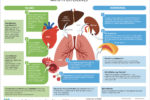Chest pain and discomfort are common symptoms that account for 1% of visits to primary care, 5% of visits to accident and emergency departments and 25% of emergency hospital admissions. Coronary artery disease (CAD) is one of many causes of chest pain and is the commonest cause of death in the UK. However, there are treatments available that can improve symptoms and prolong life, making prompt assessment and diagnosis essential. The National Institute for Health and Clinical Excellence (NICE) has recently published a new guideline on the assessment and investigation of patients presenting with acute chest pain suggestive of acute coronary syndrome (ACS) and stable chest pain suggestive of angina. It includes recommendations that will mean some changes to the way these patients are managed in practice. This article looks at how we can put these changes into action.






















